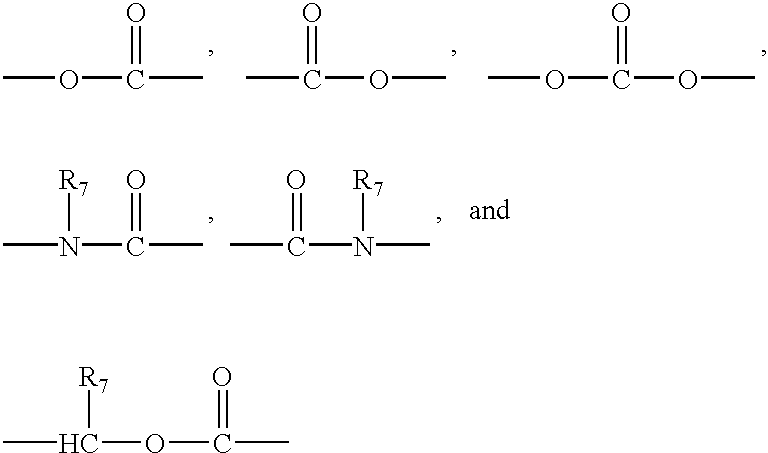Detergent compositions
a technology of detergent compositions and compositions, applied in the direction of detergent powders/flakes/sheets, detergent compounding agents, ampholytes/electroneutral surface active compounds, etc., can solve the problems of poor softening, poor cleaning, and residues on the second layer of fabri
- Summary
- Abstract
- Description
- Claims
- Application Information
AI Technical Summary
Benefits of technology
Problems solved by technology
Method used
Image
Examples
example 1
[0240]
1 % by weight, of total First phase: composition Anionic agglomerates 1 7.1 Anionic agglomerates 2 17.5 Nonionic agglomerates 9.1 Cationic agglomerates 4.6 Layered silicate 9.7 Sodium percarbonate 12.2 Bleach activator agglomerates 6.1 Sodium carbonate 7.27 EDDS / Sulphate particle 0.5 Tetrasodium salt of Hydroxyethane Diphosphonic 0.6 acid Soil release polymer 0.3 Fluorescer 0.2 Zinc Phthalocyanine sulphonate encapsulate 0.03 Soap powder 1.2 Suds suppresser 2.8 Citric acid 4.5 Protease 1 Lipase 0.35 Cellulase 0.2 Amylase 1.1 Binder spray on system 3.05 Perfume spray on 0.1 DIBS (Sodium diisobutylbenzene sulphonate) 2.1
[0241] Anionic agglomerates 1 comprise 40% anionic surfactant, 27% zeolite and 33% carbonate
[0242] Anionic agglomerates 2 comprise 40% anionic sufactant, 28% zeolite and 32% carbonate
[0243] Nonionic agglomerate comprise 26% nonionic surfactant, 6% Lutensit K-HD 96 ex BASF, 40% sodium acetate anhydrous, 20% carbonate and 8% zeolite.
[0244] Cationic agglomerate compr...
example 2
[0273]
4 % by weight, of total First phase: composition Clay extrudate 14 Flocculant agglomerate 3.8 Anionic agglomerates 1 32 Anionic agglomerates 2 2.27 Sodium percarbonate 8.0 Bleach activator agglomerates 2.31 Sodium carbonate 21.066 EDDS / Sulphate particle 0.19 Tetrasodium salt of Hydroxyethane Diphosphonic 0.34 acid Fluorescer 0.15 Zinc phtalocyanine sulphonate encapsulate 0.027 Soap powder 1.40 Suds suppresser 2.6 Citric acid 4.0 Protease 0.45 Cellulase 0.20 Amylase 0.20 Binder spray-on 2.0 Perfume spray-on 0.1
[0274] Clay extrudate comprise 97% of CSM Quest 5A clay and 3% water
[0275] Flocculant raw material is polyethylene oxide with an average molecular weight of 300,000
[0276] Anionic agglomerates 1 comprise of 40% anionic surfactant, 27% zeolite and 33% carbonate
[0277] Anionic agglomerates 2 comprise of 40% anionic surfactant, 28% zeolite and 32% carbonate
[0278] Perfume beads composition contains 46% expancel 091DE80, 8% silica, 10% silicate, 15% perfume, 5% crosslinked polyv...
example 3
[0289]
6 % by weight, of total First phase: composition Clay extrudate 13 Flocculant agglomerate 3.5 Anionic particle 38.2 Sodium percarbonate 8.0 Bleach activator agglomerates 2.3 HPA sodium tripolyphosphate 11.4 Sodium carbonate 10.043 EDDS / Sulphate particle 0.19 Tetrasodium salt of Hydroxyethane Diphosphonic 0.34 acid Fluorescer 0.15 Zinc phtalocyanine sulphonate encapsulate 0.027 Soap powder 1.40 Suds suppresser 2.6 Citric acid 1.0 Protease 0.45 Cellulase 0.20 Amylase 0.20 Perfume 1.0 Binder spray-on 2.0
[0290] Clay extrudate comprise 97% of CSM Quest SA clay and 3% water
[0291] Flocculant raw material is polyethylene oxide with an average molecular weight of 300,000
[0292] Perfume beads composition contains 46% expancel 091DE80, 8% silica, 10% silicate, 15% perfume, 5% crosslinked polyvinylalcohol-borate, 10% water and 7% sodium sulfate.
[0293] Layered silicate comprises of 95% SKS 6 and 5% silicate
[0294] Bleach activator agglomerates comprise of 81% TAED, 17% acrylic / maleic copolym...
PUM
| Property | Measurement | Unit |
|---|---|---|
| particle size | aaaaa | aaaaa |
| particle size | aaaaa | aaaaa |
| particle size | aaaaa | aaaaa |
Abstract
Description
Claims
Application Information
 Login to View More
Login to View More - R&D
- Intellectual Property
- Life Sciences
- Materials
- Tech Scout
- Unparalleled Data Quality
- Higher Quality Content
- 60% Fewer Hallucinations
Browse by: Latest US Patents, China's latest patents, Technical Efficacy Thesaurus, Application Domain, Technology Topic, Popular Technical Reports.
© 2025 PatSnap. All rights reserved.Legal|Privacy policy|Modern Slavery Act Transparency Statement|Sitemap|About US| Contact US: help@patsnap.com



